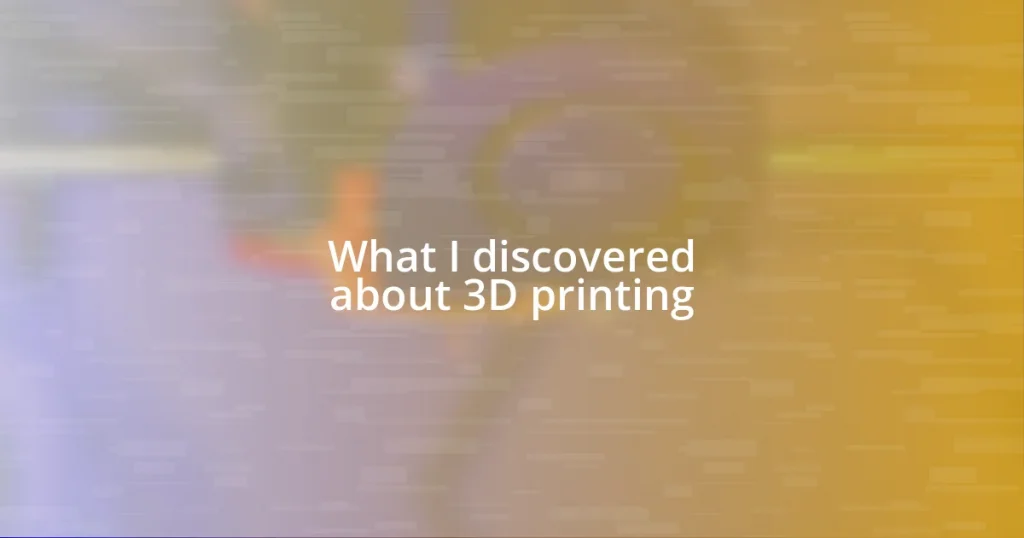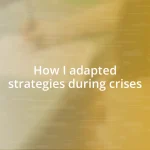Key takeaways:
- 3D printing, or additive manufacturing, transforms digital designs into physical objects, enhancing creativity and innovation accessibility across various sectors.
- Different 3D printing methods, such as FDM, SLS, and SLA, offer unique applications and benefits, including customization and reduced material waste.
- Future trends like bioprinting, AI integration, and sustainability efforts are expected to significantly advance the capabilities and environmental impact of 3D printing technology.

Introduction to 3D printing technology
3D printing technology has revolutionized the way we create and manufacture objects. It allows us to transform digital designs into tangible items layer by layer. I remember the first time I held a 3D-printed object in my hands; it felt surreal. How could a machine take something from my computer screen and bring it to life so seamlessly?
At its core, 3D printing utilizes a process known as additive manufacturing. This means that objects are built up from materials—like plastic or metal—rather than being carved out from a solid block, which is the traditional subtractive method. I often find myself amazed at the complexity achievable with such a simple principle. Have you ever pondered how this impacts creativity and innovation? It opens a world where the only limits are our imaginations.
In recent years, the accessibility of 3D printing has skyrocketed, making it easier for individuals and businesses to harness its power. I have friends who started small businesses just by using a 3D printer at home. Isn’t it incredible that a product can take shape in your garage, ultimately reaching customers around the globe? This democratization of manufacturing is something that excites me deeply—it’s a game changer.

How 3D printing works
The process of 3D printing starts with a digital file, usually created by Computer-Aided Design (CAD) software. This file then guides the printer as it lays down materials, typically plastic or resin, layer by layer. When I first tried creating my own designs, it felt empowering to see my ideas take form, even if they were just small prototypes. It highlighted how technology brings our concepts to life, right in front of our eyes.
Additive manufacturing can involve various methods, such as Fused Deposition Modeling (FDM) or Selective Laser Sintering (SLS). Each method has its unique advantages and applications. For instance, I’ve had the opportunity to see FDM in action at a local makerspace, where the printer hums away, layering filament to create intricate designs. It made me realize that the choice of technique can significantly influence the final product’s quality and functionality.
One fascinating aspect of 3D printing is its ability to produce complex geometries that traditional manufacturing simply cannot achieve. I recall being mesmerized by a demonstration of a lattice structure that was both lightweight and strong. It really got me thinking about how this technology could reshape industries—whether in aerospace, medicine, or even art.
| 3D Printing Method | Description |
|---|---|
| Fused Deposition Modeling (FDM) | melts plastic filament and extrudes it layer by layer to build the object. |
| Selective Laser Sintering (SLS) | uses a laser to fuse powdered material together to create a solid structure. |
| Stereolithography (SLA) | utilizes a UV laser to cure resin, allowing for high precision and detail. |

Types of 3D printing methods
When diving into the various types of 3D printing methods, I often find it fascinating how distinct each process can be—from the materials used to the applications they cater to. For instance, I remember my excitement the first time I witnessed a 3D printer using Fused Deposition Modeling (FDM). Watching filament melt and layer upon itself was mesmerizing, like watching a sculpture come to life in real-time. It made me reflect on how this method is often the starting point for many enthusiasts, as it’s accessible and relatively easy to use.
Here’s a quick breakdown of some prominent 3D printing methods:
- Fused Deposition Modeling (FDM): Melts plastic filament and extrudes it layer by layer to build the object.
- Selective Laser Sintering (SLS): Uses a laser to fuse powdered material together, creating a solid structure.
- Stereolithography (SLA): Utilizes a UV laser to cure resin, allowing for high precision and detail.
- Digital Light Processing (DLP): Cures resin with a digital light projector, speeding up the print process.
- Binder Jetting: Deposits a binding agent onto layers of powder, allowing for diverse materials like metals or ceramics.
The versatility of these methods is something I cherish, especially when thinking about how each technique can be tailored to different projects. I once had the chance to collaborate on a design using SLS for a functional prototype, and the precision we achieved was astonishing. The fine details and robust feel of the printed object made me truly appreciate the technology’s potential. Each method holds a unique charm and can lead to incredible creations—it’s this inventiveness that keeps my enthusiasm for 3D printing alive.

Applications of 3D printing
The applications of 3D printing truly reflect the breadth of its potential across various industries. For example, in the medical field, I was astounded to learn how 3D printing is being used to create custom prosthetics tailored to individual patients. This not only enhances comfort but also significantly reduces production time. Just imagining someone receiving a prosthetic leg that fits perfectly—well, it gives a new meaning to the phrase, “made just for you.”
In the world of aerospace, 3D printing allows for the production of lightweight, yet incredibly strong components. I vividly remember attending a workshop where an engineer showcased how they printed engine parts. The ability to reduce weight without sacrificing strength is a game-changer, especially when you consider fuel efficiency and performance. How incredible is it to think that intricate parts which previously took weeks to manufacture could now be created in a matter of days?
Even in the realm of art and design, 3D printing has made waves. I recently visited an exhibition featuring 3D-printed sculptures, and I was struck by the sheer creativity it encouraged among artists. The ability to explore forms that would be nearly impossible with traditional methods opens up limitless possibilities. Have you ever considered how 3D printing could enable artists to push the boundaries of their creations? It’s inspiring to see how technology fuels imagination!

Benefits of using 3D printing
The benefits of using 3D printing are both exciting and transformative. One major advantage is the remarkable customization it offers. I still remember when I designed a personalized phone case for a friend, tailoring it to their unique tastes. Seeing their face light up when they received it was a rewarding reminder of how 3D printing allows us to create meaningful, one-of-a-kind items that resonate on a personal level.
Another significant benefit is the reduction in material waste during production. In traditional manufacturing, excess materials are often discarded, but with 3D printing, you only use what you need. It was eye-opening to learn about a local startup that used this principle to create eco-friendly products, turning sustainability into a viable business model. Have you ever thought about how your choices might impact the environment? Diving deeper into 3D printing made me realize how such technologies can lead to a more sustainable future.
Lastly, let’s not underestimate the speed at which designs can move from concept to prototype. I vividly recall a project where a team printed a prototype overnight, significantly speeding up our testing phase. The ability to iterate quickly in design, making immediate improvements based on feedback, can dramatically enhance innovation. What does that mean for the future of product development? It suggests we might be entering an era where ideas come to life faster than ever before, fostering an environment ripe for creativity and experimentation.

Challenges in 3D printing
One significant challenge I’ve encountered in 3D printing is the issue of material compatibility. Different types of printers often require specific materials, and not all filaments work well with every machine. I remember a project where I chose a cost-effective filament hoping to save some money, only to be met with a frustrating jam. Have you ever faced a hiccup like that in your creative process? It can be disheartening when the material you think will simplify your work becomes a roadblock instead.
Another hurdle is the time it can take to learn the software associated with 3D printing. I found myself lost in a sea of options and tools when I first started creating designs. It felt overwhelming at times. I’d sit there, staring at the screen, wishing I had a manual in hand. There’s a learning curve that requires patience and commitment. But once I dedicated the time, I realized the software is truly a powerful ally. What about you? Have those initial struggles ever led to unexpected breakthroughs?
Lastly, maintaining precise calibration of the printer is crucial, and I’ve often experienced the frustrations that come from minor misalignments. There was this one project where I spent hours perfecting a model, only to find that the first few layers of the print were misaligned. Seeing that happen after investing so much effort can feel like a punch in the gut. It made me realize how critical these small details are in achieving the desired results. How do you handle setbacks like that? It’s all part of the learning experience, and I’m slowly honing my skills through each trial and error.

Future trends in 3D printing
As I look ahead, one of the most exciting trends in 3D printing is the emergence of bioprinting, which leverages 3D technology to create living tissues and organs. I remember reading about a pioneering project where researchers printed skin grafts for burn patients. The idea that we might one day print a replacement organ to save lives gives me chills. Can you imagine the implications of such advancements in medicine?
Additionally, the integration of artificial intelligence with 3D printing is on the rise. I recently experimented with a smart software that suggested design optimizations based on the functional requirements of my project. It felt like having a design assistant right there, helping me refine my work. This synergy could lead to the creation of smarter, more efficient designs with less human intervention over time. What if AI could not only assist but also inspire designs we’ve never thought of?
Furthermore, sustainability in 3D printing is gaining momentum, with an increasing focus on recycling materials. I once stumbled upon a startup that transformed plastic waste into 3D printing filament, allowing designers to create while reducing their environmental footprint. Seeing their innovation inspired me to think more creatively about waste. Could this be a turning point for the industry, where our creations not only satisfy our needs but also help heal the planet? That thought excites me as I envision a more sustainable future for 3D printing.















